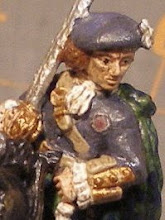Our war gaming group had its first big WW2 micro armor battle using the
Blitzkrieg Commander II rules. It was set in the North African desert somewhen around the Crusader offensive period. The battle pitted parts of the German 15th and 21st Panzer Divisions against parts of the British 7th Armored Division. The troops were supplied by Electric Ed and me and the terrain by me. We played on an 8' x 5' table set up in my garage.
The
British Germans [oops!] had the 5th Panzer Regiment Kampfgruppe (21st Panzer Division) and the 8th Panzer Regiment Kampfgruppe (15th Panzer Division), while the British had the 4th Armored Brigade Group and the 7th Armored Brigade (both of 7th Armored Division). There were three players per side, including me who also served as the game umpire/manager.
In BKC-II terms, the Germans had some 9690 points and the British had some 8605 points, each divided into two battle groups. The Germans had four panzer battalions, plus reconnaissance, artillery, and anti-tank guns. The British had six armored regiments, plus reconnaissance, artillery, and anti-tank guns. Neither side had any infantry. Almost all of the vehicles are from GHQ's very nice 1:285 scale range of WW2 micro armor.
The scenario was an encounter battle as both sides sought to reduce their opponents strength and break one or both of the enemy battlegroups.
And now on to the action. (Note: All photos taken from the British point-of-view.) [Please click on the photos to enlarge them.]
 |
| On the left, British 8th Hussars (Crusader I) maneuver against a German panzer battalion. The clear stones behind the tank stands indicate action taken during the initiative phase. |
 |
| In the center, British 2-pdr portee anti-tank guns and 7th Hussar Regiment (M3 Honey), supported by two batteries of 25-pdr field guns, maneuver against German reconnaissance units and a panzer battalion. Smoke indicates portees that have been destroyed while small blue die indicates a number of hits on a stand. |
 |
| Close-up of the burning portees with the battalion command group on the round base. |
 |
| Back on the left (by the way, this was my command) the 8th Hussars began to suffer from the fore of the German panzers. |
 |
| A close-up of the initial damage to the Hussars Crusaders with one destroyed and three others hit and suppressed. |
 |
| A view of the British center and right flank. In the center (from left) are the 7th Hussars (M3 Honey) and the 44th RTR (Valentine) while the 2nd RTR (A13) are just beyond them. On the far right are the 6th RTR (Crusader I). |
 |
| A close-up of the 44th RTR (Valentines) as they advance through a rough area. This didn't affect the tanks movement at all. |
 |
| Back on the left, the 8th Hussars are taking more hits. An understrength squadron has turned to face the German recce units that appeared on the regiment's flank. One of the Crusaders has taken hits from the German recce guns. |
 |
| On the right, Ed (commander of the 7th Armored Brigade) points out some of his tanks from the 6th RTR that have either been destroyed or damaged. |
 |
| Another shot of the action without Ed's hand in the way. You can see that the German fire has been particularly effective on this side of the action. |
 |
| A close-up of some of the damage suffered by the 6th RTR. |
 |
| Back on the left, the German recce units are stymied by the 8th Hussars squadron. One of the German recce units (Pz II from the 5th Panzer Regiment headquarters) has been suppressed by the British fire. |
 |
| And a close-up of those three Crusaders. |
The German tank and anti-tank fire was very effective, knocking out almost all of the 2-pdr portees, most of the British recce, and a significant number of British tanks. The battle ended after the fourth (of eight planned) turns with a significant German victory.
The British 7th Armored Brigade broke and the 4th Armored Brigade Group was very close to breaking. On the German side, only the 5th Panzer Regiment Kampfgruppe was very close to breaking while the 8th Panzer Regiment Kampfgruppe was still full of fight.
We enjoyed the rules and the game. This is definitely a rule set we'll continue to play as Ed and I are still in the process of raising our troops. Our target is for the Germans to have the 15th Panzer Division and the 5th Light/21st Panzer Division, while the British will have the 4th and 7th Armored Brigades of the 7th Armored Division and the 7th and 11th Indian Brigades of the 4th Indian Infantry Division, reinforced by two armored regiments from the 1st Army Tank Brigade.



































































